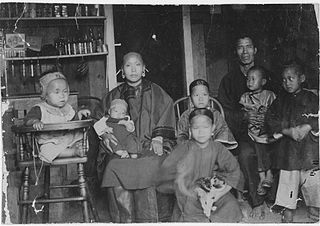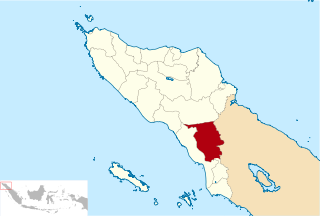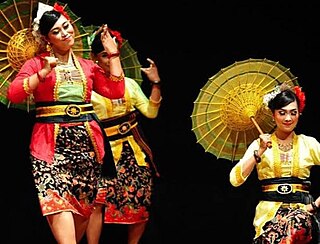
The Giriama are one of the nine ethnic groups that make up the Mijikenda.

The Chinese kinship system is among the most complicated of all the world's kinship systems. It maintains a specific designation for almost every member's kin based on their generation, lineage, relative age, and gender. The traditional system was agnatic, based on patriarchal power, patrilocal residence, and descent through the male line. Although there has been much change in China over the last century, especially after 1949, there has also been substantial continuity.

The Bunak people are an ethnic group that live in the mountainous region of central Timor, split between the political boundary between West Timor, Indonesia, particularly in Lamaknen District and East Timor. Their language is one of those on Timor which is not an Austronesian language, but rather a Papuan language, belonging to the Trans–New Guinea linguistic family. They are surrounded by groups which speak Malayo-Polynesian languages, like the Atoni and the Tetum.

The Karo, or Karonese, are a people of the Tanah Karo and part of the Karo people from North Sumatra, Indonesia. The Karo lands consist of Karo Regency, plus neighboring areas in East Aceh Regency, Langkat Regency, Dairi Regency, Simalungun Regency, and Deli Serdang Regency. In addition, the cities of Binjai and Medan, both bordered by Deli Serdang Regency, contain significant Karo populations, particularly in the Padang Bulan area of Medan. The town of Sibolangit, Deli Serdang Regency in the foothills of the road from Medan to Berastagi is also a significant Karo town.

The Hmong people are an ethnic group currently native to several countries, believed to have come from the Yangtze river basin area in southern China. The Hmong are known in China as the Miao, which encompasses not only Hmong, but also other related groups such as Hmu, Qo Xiong and A-Hmao. There is debate about usage of this term, especially amongst Hmong living in the West, as it is believed by some to be derogatory, although Hmong living in China still call themselves by this name. Throughout recorded history, the Hmong have remained identifiable as Hmong because they have maintained the Hmong language, customs, and ways of life while adopting the ways of the country in which they live. In the 1960s and 1970s, many Hmong were secretly recruited by the American CIA to fight against communism during the Vietnam War. After American armed forces pulled out of Vietnam the Pathet Lao, a communist regime, took over in Laos and ordered the prosecution and re-education of all those who had fought against its cause during the war. While many Hmong are still left in Laos, Thailand, Vietnam, Myanmar, and China, since 1975 many Hmong have fled Laos in fear of persecution. Housed in Thai refugee camps during the 1980s, many have resettled in countries such as the United States, French Guiana, Australia, France, Germany, as well as some who have chosen to stay in Thailand in hope of returning to their own land. In the United States, new generations of Hmong are gradually assimilating into American society while being taught Hmong culture and history by their elders. Many fear that as the older generations pass on, the knowledge of the Hmong among Hmong Americans will die as well.
The Hupda are an Amazonian indigenous people who live in Brazil and Colombia. They speak the Hup language.

Southeast Aceh Regency is a regency in the Aceh province of Indonesia. It is located on the island of Sumatra. In 1974, the Southeast Aceh Regency was created by being separated from the Central Aceh Regency; however in 2002 the northern part of this regency was itself split away to form the new Gayo Lues Regency. The regency now covers an area of 4,242.04 square kilometres and had a population of 179,010 at the 2010 census and 220,860 at the 2020 Census; the official estimate as at mid 2023 was 229,368. The seat of the regency government is at the town of Kutacane.

The Xhosa people, or Xhosa-speaking people are a Bantu ethnic group native to South Africa and they are the second largest ethnic group in Southern Africa and are native speakers of the IsiXhosa language.

The Acehnese are an indigenous ethnic group from Aceh, Indonesia on the northernmost tip of the island of Sumatra. The area has a history of political struggle against the Dutch colonial rule. The vast majority of the Acehnese people are Muslims. The Acehnese people are also referred to by other names such as Lam Muri, Lambri, Akhir, Achin, Asji, A-tse and Atse. Their language, Acehnese, belongs to the Aceh–Chamic group of Malayo-Polynesian of the Austronesian language family.
The Meenkulathi Temple is located in Pallassena, a village in southern India.

The Gayo people are an ethnic group living in the highlands of Aceh Province, Sumatra, Indonesia. The Gayo tribe has a population of 336,856 and they live predominantly in the mountains. Most Gayo live in three regencies in Aceh namely Bener Meriah, Central Aceh, and Gayo Lues. Some of them live in several districts in other regencies, such as Serbejadi District, Simpang Jernih District, and Peunaron District in East Aceh Regency and Beutong District in Nagan Raya Regency. Other than that, the Gayo population also covers Southeast Aceh Regency and Aceh Tamiang Regency. Their homeland lies in the Barisan Mountains which has elevations of over 12,000 feet and extends more than one thousand miles. The Gayonese language has four dialects: Lut, Serbejadi-Lukup, Lut and Luwes. Their language does not have a writing system, but folk tales, stories and poetry are passed down in oral tradition. The traditional house of the Gayo is called Umah.
Pakpak people or Batak Pakpak are one of the ethnic groups found mainly in North Sumatra, Indonesia. They are scattered in a few regencies and cities in North Sumatra and Aceh, such as Dairi Regency, Pakpak Bharat Regency, Humbang Hasundutan Regency and Central Tapanuli Regency of North Sumatra, and also in Aceh Singkil Regency and Subulussalam, Aceh. Pakpak people have some communities in other cities across Indonesia. The term "Batak Pakpak" also refers to the culture and language of the Pakpak people.

Singkil people are an ethnic group of people found in Aceh Singkil Regency and Subulussalam, Aceh province, Indonesia.

The Alas people is an indigenous ethnic group from Kutacane, Southeast Aceh district, Sumatra, Indonesia. The Alas are found in the Gunung Leuser, Ketambe, and Alas River areas.
Kluet or Kluwat people dwell in a number of districts in South Aceh Regency, Aceh, Indonesia namely North Kluet, South Kluet, Central Kluet and East Kluet. The Kluet people are regarded as part of the Batak people sub-ethnicity. The Kluet regions are separated by Lawé Kluet River, where it disgorges from the Mount Leuser and disembogues into the Indian Ocean. Residential region of the Kluet people is 30 km from Tapaktuan city or 500 km from Banda Aceh. Majority of the population and as well as the Kluet people practices Islam.
Henricus Marinus Neeb, often recorded as H.M. Neeb, was a Dutch military doctor during the later stages of the long lasting Aceh War. He photographed sights in the area beginning in 1904 including architecture, indigenous peoples, colonial buildings such rail infrastructure and buildings, topography, scenes of Dutch soldiers, and Acehnese killed in the conflict.

Payung dance is a folk dance-drama tradition of the Minangkabau-Malay ethnic group in Sumatra, Indonesia. This dance is a Minangkabau version of other Malay dances from Sumatra. Folk theatre such as toneel and sandiwara often incorporate payung dance as part of the show. The payung (umbrella) is the main prop used in this dance. The payung dance symbolizes affection and the relationship of young people and is usually performed by three or four dancers. The dance originates from Western Sumatra, Indonesia.

Minangkabau culture is the culture of the Minangkabau ethnic group in Indonesia, part of the Indonesian culture. This culture is one of the two major cultures in the Indonesian archipelago which is very prominent and influential.













